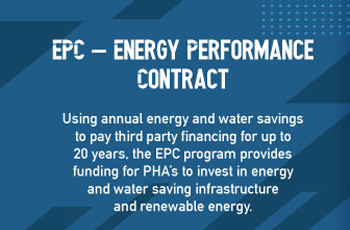
The Energy Performance Contract program (EPC) is a financing technique that uses energy and/or water cost savings from reduced energy and/or water consumption to repay the cost of installing Energy Conservation Measures (ECMs). EPC can pay for today's facility upgrades with tomorrow's energy and/or water savings. Performance contracting is used in other sectors, including federal facilities, schools, and universities.
In the Office of Public and Indian Housing Operating Fund EPC program, housing authorities may develop and implement cost-effective retrofits, or they may contract development and implementation with companies called Energy Service Companies (ESCOs) that work in this market and contract with institutional energy and/or water users such as housing authorities. ESCOs usually provide guarantees of success and ongoing measurement and verification of performance.
Coming Soon
For more information about HUD’s Energy Performance Contract program please see below or contact us at PIHEnergyBranch@hud.gov
- PIH OpFund EPC Guidance Memo (03/14/2011)
- EPC and the Rental Assistance Demonstration (RAD) program
- EPC Program FAQs
- EPC Program Success Stories
- HUD EPC Measurement & Verification (M&V) Guidelines (01/21/2011)
- DOE/FEMP M&V Guidelines for Performance-Based Contracts (11/2015)
- Guidance for PHAs on Energy Performance Contracts (EPC) and SAC Section 18 Applications (09/2022)
- Section 18 Demo/Dispo Checklist (09/2022)
- HUD Utility Baseline Review Process (04/08/2010)
- Conditions for Construction Contracts - Public Housing Programs (HUD form 5370) (01/2014)
- Implementation of Minimum Heating Standards in Public Housing Properties (PIH Notice 2018-19)
- Using Energy Star to Promote Energy Efficiency in Public Housing (PIH 2010-41)
- Partnering with Utility Companies on Energy Performance Contracts (PIH Notice 2018-20)
- EPC Proposal Completeness Review Checklist (MS-Word)
- EPC Proposal Technical Review Checklist (MS-Word)
- EPC Request for Proposal (RFP) Checklist (MS-Word)
- HUD Energy Cost Summary Worksheet (MS-Excel)
- Sample EPC Request for Proposal (RFP) (MS-Word)
- Sample EPC Legal Review Document (MS-Word)
- Sample EPC Cost Reasonableness Certification Memo (MS-Word)
- Sample EPC Repayment Certification Memo (MS-Word)
Understanding the Measurement & Verification (M&V) Process
This training video explains how to measure and verify EPC savings, discusses the key information and documents involved in the Measurement & Verification (M&V) process, and provides instructions on calculating savings for various M&V options.
How Do Baseline Adjustments Affect My Subsidy?
This training video explains how a utility baseline is established, discusses different types of baseline adjustments and what is allowed by HUD, and covers examples of baseline adjustments.
What are Eligible Energy Performance Contract (EPC) Project Costs?
This training video explains eligible project costs for an EPC, the importance of project costs in an EPC, and how to calculate and allocate project costs as part of the M&V process.
How Do I Determine Frozen Rolling Base (FRB) Savings?
This training video defines the Frozen Rolling Base (FRB) incentive and explains how to calculate and request the FRB incentive.
How Do I Determine Resident Paid Utilities (RPU) Savings?
This training video defines the Resident Paid Utilities (RPU) incentive, explains how the RPU incentive can be used in an EPC, and provides example calculations for determining savings for RPU in the M&V process.
How Do I Determine Add-On Subsidy (AOS) Savings?
This training video defines the Add-On Subsidy (AOS) incentive, discusses the different types of M&V (Option A and Option C) which can be used to determine AOS savings, and explains how to calculate the lesser of project costs/savings and request the AOS incentive.
How Does the 75 Percent Rule Impact Savings?
This training video explains the regulatory basis of the 75 percent rule, how it applies to an EPC in relation to the FRB and RPU incentives, and how to minimize HUD recapture from the 75 percent rule through proper calculation of project costs/savings associated with these incentives.
What is Cross-Subsidization of EPC Incentives?
This training video explains the concept of cross-subsidization and how EPC incentives can work together to minimize HUD recapture and maximize EPC project performance.